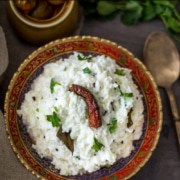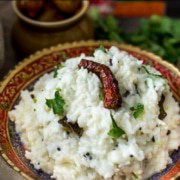The fragile and mild-flavored South Indian curd rice (also often called thayir sadam or yogurt rice) is a befitting finale to a luxurious spicy meal. Learn the right way to make this comfort food in under half-hour.
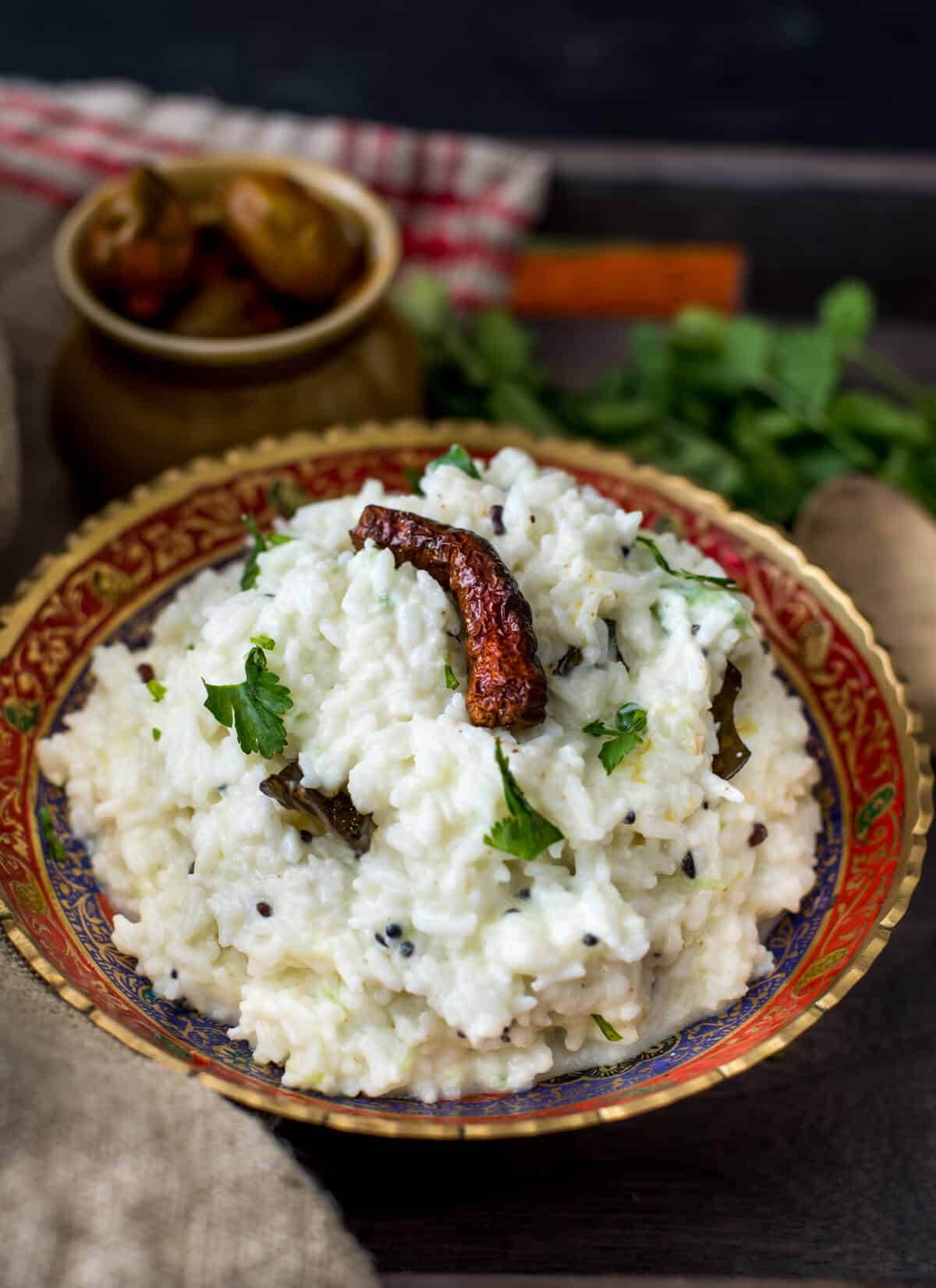
What’s curd rice?
The mixture of cooked rice and curd, commonly often called curd rice or dahi bhaat, is a dish that’s savored across India, but it surely is within the South that it has come by itself with a tempering that adds a fragile and refreshing flavor to the yogurt and rice mixture.
The tempered yogurt rice version is popular in restaurants and in South Indian temples (where it is obtainable as a holy offering to gods after which distributed amongst devotees as prasad).
The untempered version is more commonly served in South Indian homes at the top of each meal. It helps soothe the stomach after a spicy meal; the probiotics within the curd help aid digestion, and it is ideal to combat the recent summer days that the parents in South India often experience.
Curd rice / thayir sadam / yogurt rice
Across southern India, curd rice is referred to by different names; in Tamil Nadu, it’s often called thayir sadam, where. In Andhra Pradesh and Telangana, it is known as daddojanam; in Karnataka, it’s often called masruanna or mosaranna, and thayir choru in Kerala.
In northern and western India, curd rice goes by dahi baat or dahi chawal, where dahi means curd and chawal / bhaat stands for rice.
No matter what it is known as, the preparation is generally the identical barring just a few Indian spices.
Are curd and yogurt the identical?
No – yogurt is commercially produced, whereas curd is homemade.
Each curd and yogurt are made by boiling after which cooling the milk before adding a bacterial culture to it.
The difference is that homemade curd incorporates just one strain of bacteria (Lactobacillus), whereas commercially prepared yogurt normally has two strains of bacteria (Lactobacillus Bulgaris and Streptococcus thermophilus).
Since yogurt is commercially prepared and under controlled conditions, the final result is standardized and has the best amount of bacteria. The bacterial strength of homemade, fresh curd may vary from one household to the opposite, depending on the culture used.
Helpful resource: Difference between curd and yogurt.
Fun fact: The term curd is generally utilized in India, whereas within the US, even the homemade ones are called yogurt.
Reasons to like this recipe
There are lots of reasons to like this creamy curd rice recipe, and listed here are just a few of our favourite ones –
- A straightforward yet satiating meal that takes lower than half-hour!
- Perfect for days when you might have an upset stomach – it’s light in your tummy, and the probiotic within the yogurt helps aid digestion.
- It tastes great even after just a few hours, making it perfect for travel and faculty/work lunches.
- A cooling meal or a side dish for warm summers.
My tryst with thayir saadam
I first became acquainted with this dish after I first had it at a South Indian buffet. I even have at all times liked curd, so obviously, I used to be drawn to this tempered, creamy rice and yogurt combination. I used to be hooked at the primary bite, and I remember refilling my plate so again and again that I had no place for dessert.
No regrets, though, because I totally enjoyed it.
Health advantages
There are lots of health advantages of curd rice, and probably the most common ones are that it aids digestion, and has a soothing and cooling effect on the body. It also incorporates probiotics, antioxidants, and helpful fats, and that’s why it is particularly beneficial for individuals who have an upset stomach.
Here’s what it’s good to make the recipe
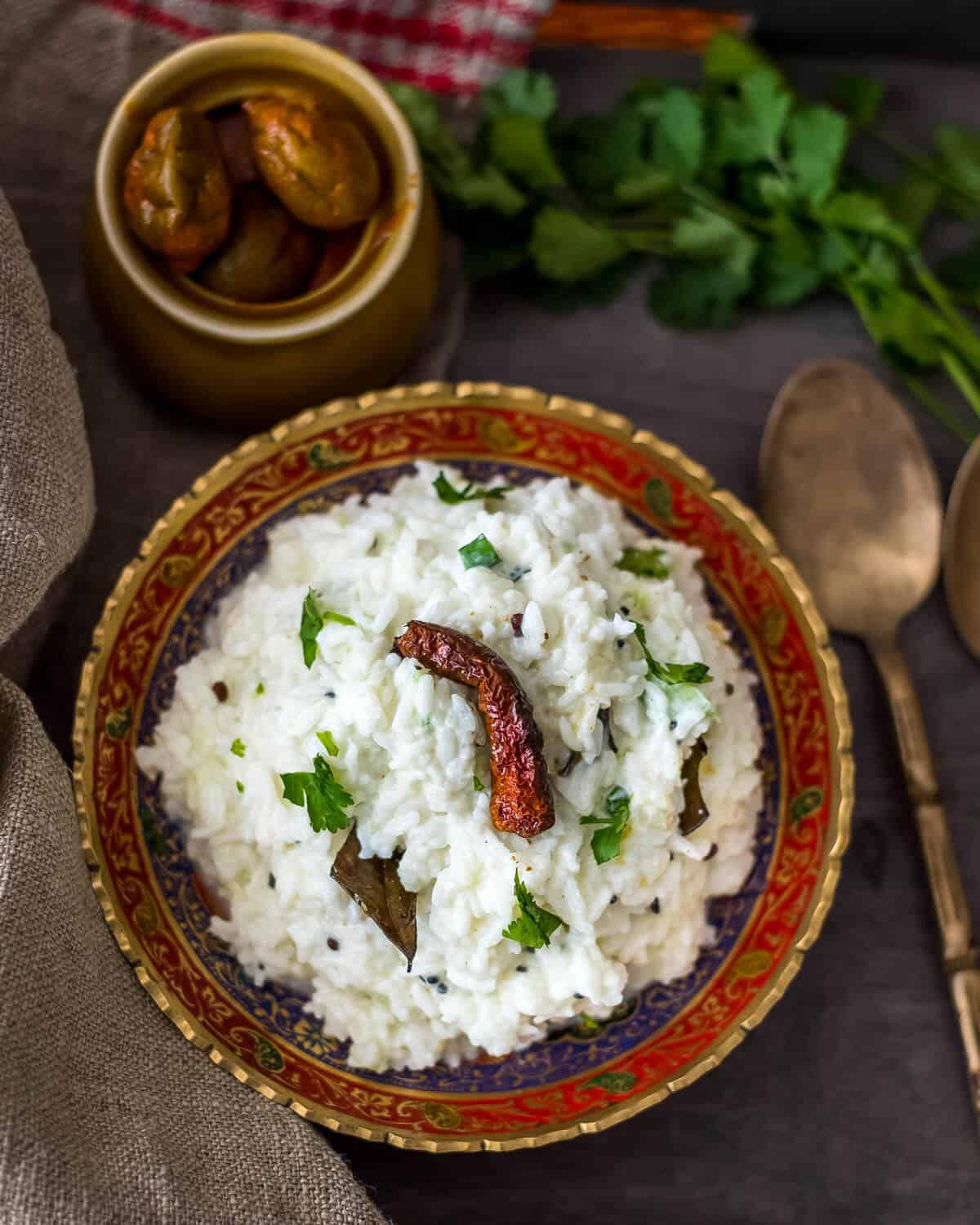
make the proper curd rice?
That’s because freshly cooked rice tends to be moister and might be easily mushed. Having said that, you may definitely use leftover refrigerated rice. You’ll should sprinkle just a few tablespoons of water first and microwave it for 30 to 60 seconds until it has softened a bit.
When you are making white rice from scratch, cook it to the purpose that it’s overcooked and mushy by utilizing at the least two times more water than usual.
Allow the rice to chill down, then mix it with yogurt, salt, green chilies, and grated veggies, similar to cucumber and carrots, until well combined. Traditionally, thayir saadam is made by combining the ingredients using clean fingers till you get a lump-free, homogenous mixture. But when that isn’t your style, be at liberty to make use of the back of a ladle to mush the rice and yogurt mixture.
To complete the dish, mustard seeds, curry leaves, red chilies, a little bit of hing, urad dal, and cashews (optional) are added to hot oil or ghee. This mixture is known as tempering, aka tadka, which is then added to the mashed rice mixture.
Right before serving, dahi rice or dahi baat might be sprinkled with finely chopped cilantro or coriander leaves. Sometimes it’s served with chopped grapes or pomegranate arils as well.
Step-by-step instructions to make curd rice
- Cook rice with almost twice the amount of water over the stovetop or in an electrical pressure cooker similar to the Easy Pot. For 1 cup of Basmati rice, use 2 cups of water; for 1 cup of Sona masoori rice, use 2.5 cups of water when using an Easy Pot.
- Pressure cook Basmati rice for six minutes and Sona masoori rice for 10 minutes. When the cooking cycle is complete, release the pressure. Mash the rice with a back of a ladle till it is totally mushed. Remove the inner pot from the Easy Pot and permit the rice to chill for at the least quarter-hour.
- Whisk yogurt with milk till they’re well combined. Mix well with grated cucumber, green chilies, salt, and grated ginger.
- Add the yogurt mixture to the rice and blend it by hand or use the back of a ladle.
- Add oil or ghee to the tadka pan kept over medium heat.
- When the oil is hot, add mustard seeds and asafoetida. Once the mustard seeds begin to sputter, add urad, red chili, and a sprig of curry leaves.
- Allow them to sizzle for about 10 seconds, after which pour this mixture over the curd rice mixture. Garnish with cilantro and blend well.
- Serve accompanied by lemon or mango pickle and/or papads.
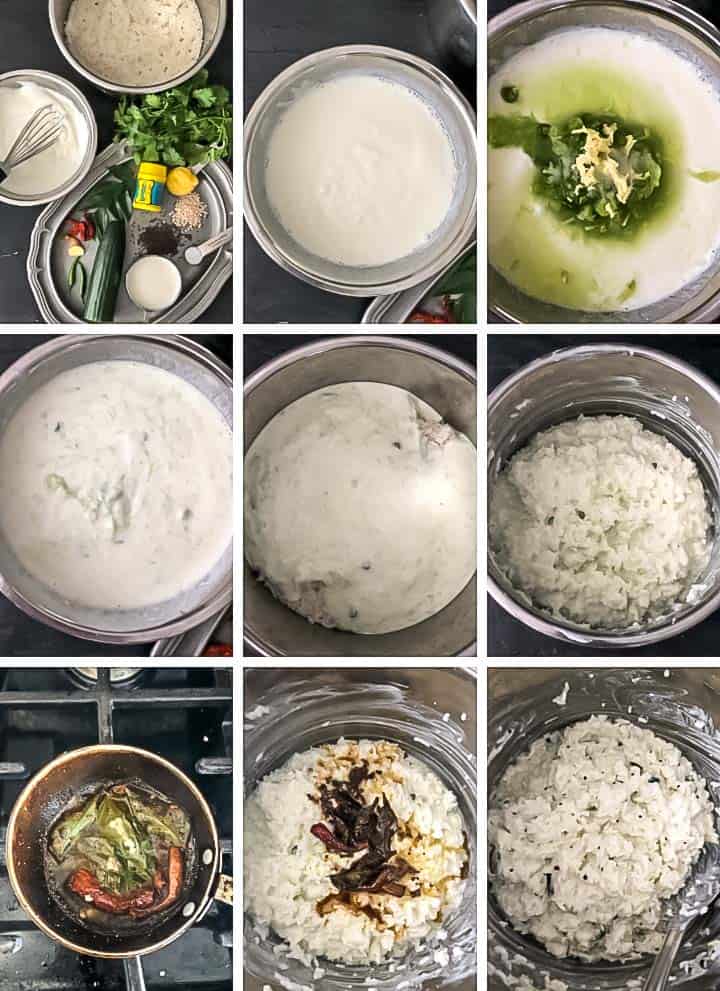
Substitutions/variations
- Substituting white rice – You may also make it with brown rice or quinoa as an alternative of white rice.
- Fruit and veggies – grated carrots, cucumber, or grated green mango make great additions to this dish.
- Tempering – You possibly can add halved cashews to the tempering, and in the event you don’t mind a touch of sweetness, be at liberty so as to add golden raisins. Fry the cashews till they’re golden brown, after which add raisins. Turn off the warmth when the raisins begin to plump.
- Garnishes vary from household to household, but chopped cilantro, halved grapes, and pomegranate seeds are probably the most common.

Storage suggestions
Refrigerator: This South Indian curd rice might be stored within the refrigerator for as much as 2-3 days in an air-tight container.
Freezer: Frozen yogurt separates and gets grainy and watery when thawed. That’s why I wouldn’t recommend freezing yogurt rice.
Reheat: Yogurt breaks down when heated, so I wouldn’t recommend heating curd rice. You possibly can serve yogurt rice cold or at room temperature (just let it sit out for 15-20 minutes). While you refrigerate curd rice, it’ll solidify and lose its creamy texture. To repair it, add just a few tablespoons of milk and blend well.
prep ahead
You possibly can prep ahead by cooking the rice a day upfront. You may also grate the cucumber and carrots (if using) and store them within the refrigerator for as much as 2 days.

South Indian Curd Rice Recipe (Thayir sadam)
The fragile and mild flavored curd rice (also often called thayir sadam or yogurt rice) is a befitting finale to a luxurious spicy meal. Learn the right way to make this comfort food in under 30-minutes.
- 1 cup uncooked rice (or 3 cups cooked) sona masoori or Basmati
- 2-2.5 cups water
- 2 cups thick yogurt fresh, preferably
- ½ – 1 cup whole milk
- 1 cup grated cucumber optional
- 1-2 Indian or Thai green chilies (Bird’s eye) chopped finely
- 1 inch-piece ginger finely grated
For tempering
- 1 tablespoon oil or ghee
- 1 teaspoon mustard seeds
- ¼ teaspoon asafoetida
- 1 teaspoon urad dal washed and rinsed
- 2 whole dried red chili halved
- A sprig of curry leaves
Optional garnishes
- ¼ cup finely chopped cilantro optional
- ¼ cup pomegranate seeds optional
Prevent your screen from going dark
Cooking rice within the Easy Pot
Rinse the rice using a strainer till the water runs clear.
Soak the rice in twice the quantity of water for half-hour. You possibly can skip this step in the event you are in a rush.
Add water (2 cups for Basmati or 2.5 cups for Sona masoori) to the inner pot of the Easy Pot.
Drain the rice and add it to the inner pot. Mix well.
Close the lid and set the steam valve to sealing.
Pressure cook for 6 minutes for Basmati rice and 10 minutes for sona masoori rice.
When the cooking cycle is complete, open the lid and let the steam escape.
Use the back of the ladle and mash the rice. Remove the inner pot from the Easy Pot. Set it aside to chill for at the least 15-20 minutes.
- Cook rice with almost twice the quantity of water – this overcooks and softens it, making it easier to mush.
- Freshly cooked rice tends to be more moist and might be easily mushed; that’s why it is normally preferred. When you are using refrigerated leftover rice, sprinkle just a few tablespoons of water first and microwave it for 30 to 60 seconds until it has softened a bit.
- Cool rice for 15-20 minutes before mixing it with curd. Mixing hot rice with curd will result in curd breaking down and becoming grainy.
- Add whole milk: Milk helps reduce sourness and offers this curd rice a creamy texture. It’s okay to skip it in the event you plan to eat inside just a few hours.
- Use store-bought or homemade ghee so as to add more flavor to the dish.
- Use creamy, full-fat, fresh yogurt for best results.
Disclaimer: Approximate dietary information is provided as a courtesy and might vary depending on the precise ingredients/brands used. If you might have health issues, please work with a registered dietician or nutritionist.
Calories: 208kcalCarbohydrates: 31gProtein: 6gFat: 6gSaturated Fat: 4gPolyunsaturated Fat: 0.3gMonounsaturated Fat: 2gCholesterol: 19mgSodium: 77mgPotassium: 235mgFiber: 1gSugar: 6gVitamin A: 174IUVitamin C: 2mgCalcium: 141mgIron: 0.5mg
This post was published on Feb 22, 2019, and has been completely updated with latest information (images and text) on May 1, 2023.


